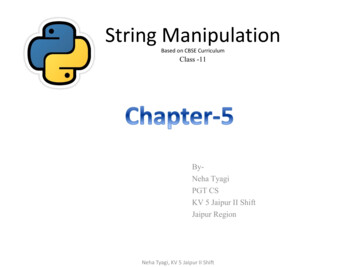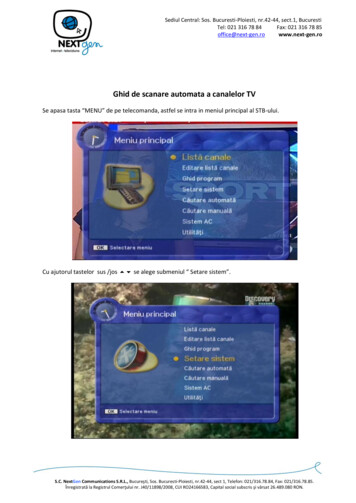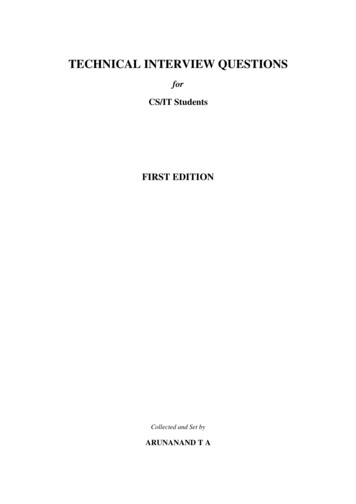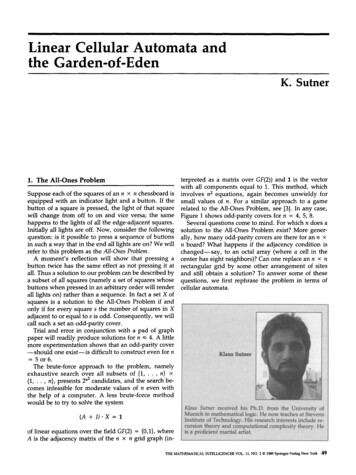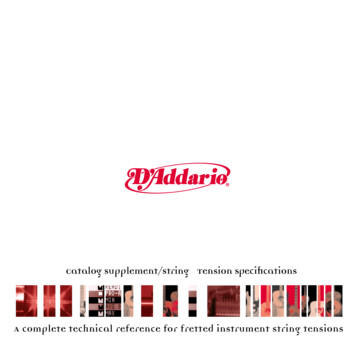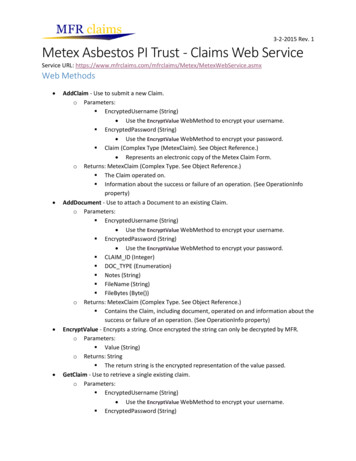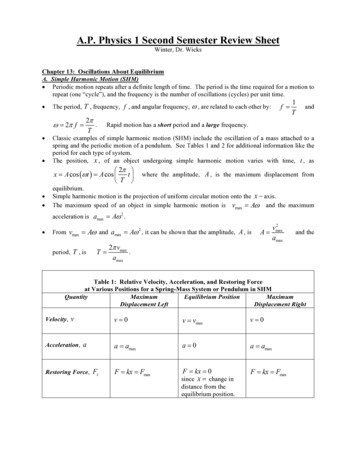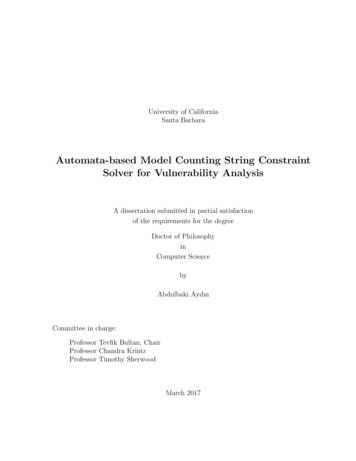
Transcription
University of CaliforniaSanta BarbaraAutomata-based Model Counting String ConstraintSolver for Vulnerability AnalysisA dissertation submitted in partial satisfactionof the requirements for the degreeDoctor of PhilosophyinComputer SciencebyAbdulbaki AydınCommittee in charge:Professor Tevfik Bultan, ChairProfessor Chandra KrintzProfessor Timothy SherwoodMarch 2017
The Dissertation of Abdulbaki Aydın is approved.Professor Chandra KrintzProfessor Timothy SherwoodProfessor Tevfik Bultan, Committee ChairMarch 2017
Automata-based Model Counting String Constraint Solver for Vulnerability AnalysisCopyright c 2017byAbdulbaki Aydıniii
To my lovely wife,Yasemin,my parents, and my kids.iv
AcknowledgementsI would like to thank my advisor, Professor Tevfik Bultan, for his unlimited supportI enjoyed during my PhD journey. He is an excellent advisor with amazing technical andsoft skills. I was inspired by his passion to push the limits of the state of the art researchin computer science. He devoted considerable amount of time discussing ideas with hisknowledge, enthusiasm, and motivation. He was always ready to help me no matter theeffort implied.I would also like to thank Professor Chandra Krintz and Professor Timothy Sherwoodfor serving on my committee and for giving great feedback and vision throughout my PhDjourney.I had the privilege to work with wonderful people at Verfication Lab (VLab). Specialthanks to Lucas Bang and Muath Alkhalaf whom I worked closely most of the time.I would like to thank to former VLab member Ivan Bocić and recent VLab membersWilliam Eiers, Tegan Brennan, Nicolás Rosner, and Nestan Tsiskaridze for the greatresearch and friendship environment.My parents, Hüseyin Aydın and Fatma Aydın and my parents-in-law, Necati Şahinand Güler Şahin gave all the blessings and support with love. My sisters and brothersSümeyra Aydın Özkan, Kübra Aydın, İbrahim Aydın, and Muhammed Aydın, and mysisters-in-law Aybüke Şahin and Ayşegül Şahin Varol were always there to encourageand support me with their unlimited love. I am thankful to God for having such a greatfamily.I would like to send my love to my son, Eymen Asaf Aydın, who kept me hopefuleveryday with his beautiful smiles even though he is too little to understand that.Finally, I would like to thank my beautiful and lovely wife, Yasemin Şahin Aydın,this was only possible with you by my side.v
Curriculum VitæAbdulbaki AydınEducation2017201620092009Ph.D. in Computer Science, University of California, Santa Barbara,USA.M.S. in Computer Science, University of California, Santa Barbara,USA.B.S. in Computer Engineering, Fatih University, Istanbul, Turkey.B.S. in Electric-Electronics Engineering, Fatih University, Istanbul,Turkey.PublicationsAbdulbaki Aydin, David Piorkowski, Omer Tripp, Pietro Ferrara, and Marco Pistoia,Visual Configuration of Mobile Privacy Policies, in Proceedings of the 20th InternationalConference on Fundamental Approaches to Software Engineering, Held as Part of theEuropean Joint Conferences on Theory and Practice of Software, ETAPS 2017, FASE2017.Lucas Bang, Abdulbaki Aydin, Quoc-Sang Phan, Corina S. Pasareanu, and Tevfik Bultan, String Analysis for Side Channels with Segmented Oracles, in Proceedings of the24th ACM SIGSOFT International Symposium on Foundations of Software Engineering,FSE 2016.Abdulbaki Aydin, Lucas Bang, and Tevfik Bultan, Automata-Based Model Countingfor String Constraints, in Proceedings of the 27th International Conference on ComputerAided Verification, CAV 2015.Lucas Bang, Abdulbaki Aydin, and Tevfik Bultan, Automatically Computing Path Complexity of Programs, in Proceedings of the 2015 10th Joint Meeting on Foundations ofSoftware Engineering, ESEC/FSE 2015.Abdulbaki Aydin, Muath Alkhalaf, and Tevfik Bultan, Automated Test Generation fromVulnerability Signatures, in Proceedings of the 7th IEEE International Conference onSoftware Testing, Verification and Validation, ICST 2014.Muath Alkhalaf, Abdulbaki Aydin, and Tevfik Bultan, Semantic Differential Repair forInput Validation and Sanitization, in Proceedings of the 2014 International Symposiumon Software Testing and Analysis, ISSTA 2014.vi
AbstractAutomata-based Model Counting String Constraint Solver for Vulnerability AnalysisbyAbdulbaki AydınMost common vulnerabilities in modern software applications are due to errors instring manipulation code. String constraint solvers are essential components of programanalysis techniques for detecting and repairing vulnerabilities that are due to stringmanipulation errors. In this dissertation, we present an automata-based string constraintsolver for vulnerability analysis of string manipulating programs.Given a string constraint, we generate an automaton that accepts all solutions thatsatisfy the constraint. Our string constraint solver can also map linear arithmetic constraints to automata in order to handle constraints on string lengths. By integrating ourstring constraint solver to a symbolic execution tool, we can check for string manipulationerrors in programs. Recently, quantitative and probabilistic program analyses techniqueshave been proposed which require counting the number of solutions to string constraints.We extend our string constraint solver with model counting capability based on the observation that, using an automata-based constraint representation, model counting reducesto path counting, which can be solved precisely. Our approach is parameterized in thesense that, we do not assume a finite domain size during automata construction, resulting in a potentially infinite set of solutions, and our model counting approach works forarbitrarily large bounds.We have implemented our approach in a tool called ABC (Automata-Based modelCounter) using a constraint language that is compatible with the SMTLIB languagespecification used by satisfiability-modulo-theories solvers. This SMTLIB interface favii
cilitates integration of our constraint solver with existing symbolic execution tools. Wedemonstrate the effectiveness of ABC on a large set of string constraints extracted fromreal-world web applications.We also present automata-based testing techniques for string manipulating programs.A vulnerability signature is a characterization of all user inputs that can be used to exploit a vulnerability. Automata-based static string analysis techniques allow automatedcomputation of vulnerability signatures represented as automata. Given a vulnerabilitysignature represented as an automaton, we present algorithms for test case generationbased on state, transition, and path coverage. These automatically generated test casescan be used to test applications that are not analyzable statically, and to discover attackstrings that demonstrate how the vulnerabilities can be exploited. We experimentallycompare different coverage criteria and demonstrate the effectiveness of our test generation approach.viii
ContentsCurriculum VitaeviAbstractvii1 Introduction2 Background2.1 Symbolic Verification . . .2.2 Symbolic Execution . . . .2.3 String Constraint Solving .2.4 Model Counting . . . . . .1.551115163 Constraint Language3.1 Language Semantics . . . . . . . . . . . . . . . . . . . . . . . . . . . . .3.2 Mapping of Java String Expressions to the Constraint Language . . . . .3.3 Mapping of PHP String Expressions to the Constraint Language . . . . .202028304 Automata-based Constraint Solving4.1 Mapping Formulae to Automata . . . . . . . . . . . . . . . . . . . . . . .4.2 Handling Atomic Constraints . . . . . . . . . . . . . . . . . . . . . . . .4.3 Automata Construction Semantics . . . . . . . . . . . . . . . . . . . . . .313336405 Relational Constraint Solving5.1 String Constraint Solving . . . . . . . . . . . . . . . . . . . . . . . . . . .5.2 Integer Constraint Solving . . . . . . . . . . . . . . . . . . . . . . . . . .5.3 Mixed Constraint Solving . . . . . . . . . . . . . . . . . . . . . . . . . .465056576 Constraint Simplification Heuristics647 Automata-based Model Counting67.ix.
8 ABC Tool8.1 Architecture . . . . . . . . . . . . . . . . . . . . . . . . . . . . . . . . . .8.2 Experimental Evaluation . . . . . . . . . . . . . . . . . . . . . . . . . . .7777799 Automated Test Case Generation via String Analysis899.1 Motivation and Overview . . . . . . . . . . . . . . . . . . . . . . . . . . . 909.2 Converting Vulnerability Signature Automata to DAGs . . . . . . . . . . 969.3 State and Transition Coverage for Vulnerability Signature Automata UsingMin-Cover Paths Algorithm . . . . . . . . . . . . . . . . . . . . . . . . . 999.4 Path Coverage for for Vulnerability Signature Automata Using Depth FirstTraversal . . . . . . . . . . . . . . . . . . . . . . . . . . . . . . . . . . . . 1079.5 Implementation and Experiments . . . . . . . . . . . . . . . . . . . . . . 10810 Conclusion113Bibliography115x
Chapter 1IntroductionSupport for string manipulation in programming languages has been increasing due to thecommon usage of strings in modern software applications. For example, many modernsoftware applications are web applications, and most of what web applications do is stringprocessing. Common uses of string manipulation in modern software development are asfollows: Input validation and sanitization: Most modern software applications are webbased and the user inputs to web applications typically come in the string form.The input string entered by the user is parsed by the web application and canbe used as the input parameter for the action that is executed in response to theuser’s request. Web applications are globally accessible and any user can interactwith them from all over the world. A user can input a string in an undesiredformat or a malicious user can input a string that contains hidden commands.Application developers cannot trust that user input is valid and safe; they need tovalidate and/or sanitize user input to keep application and its data in a consistentstate and to avoid vulnerabilities. Input validation rejects user input if it is not indesired format or if it contains harmful string patterns. Input sanitization modifies1
IntroductionChapter 1user input string to transform it into a safe and valid input parameter to theweb application. Both input validation and sanitization involves extensive stringmanipulation since user inputs are typically in string form. Database query generation: Many modern software applications have a back-enddatabase component to store data. Many user interactions with the applicationcan trigger database queries, which are constructed at runtime using string manipulation. Formatted data generation: Modern software applications commonly use wellknown data formats to store, exchange, or describe data. XML and JSON are twoof the widely used data formats. HTML is the most common format worldwideto describe web documents and to display user input forms in web applications.Creation of such data formats involves extensive string manipulation. Dynamic code generation: Many modern software applications are highly dynamicwhere application code is generated on the fly based on user input. In case of webapplications, dynamically generated code can correspond to client side code (e.g.,JavaScript) or in some cases it can correspond to server side code. In both cases,dynamic code generation requires string manipulation.In all use cases listed above, errors in string manipulation code can have disastrouseffects. Analyzing string manipulation code is extremely important in order to avoidfailures in modern software. String analysis aims to automatically analyze string manipulation code to check its correctness, based on the developer’s expectations. It is a staticprogram analysis technique that determines the values that a string expression can takeduring program execution. String analysis can be used to solve many problems in modernsoftware systems that relate to string manipulation. It can be applied, e.g., to identify2
IntroductionChapter 1security vulnerabilities by checking if a security sensitive function receives an input thatcontains an exploit [1, 2, 3, 4], to identify set of user inputs that reaches to a sensitivefunction with certain values [5], to generate test cases from set of string values of a stringexpression [6], to identify data format generation errors [7], to identify the set of queriesthat are sent to back-end database [8, 2], to identify set of dynamically generated code(e.g., client-side code) [9, 10, 11], and to generate patches for string manipulation code(e.g., patching input validation and sanitization functions) [12, 13].Like many other program-analysis problems, it is not possible to solve the stringanalysis problem precisely (i.e., it is not possible to precisely determine the set of stringvalues that can reach a program point). However, one can compute over- or underapproximations of possible string values. If the approximations are precise enough, theycan enable us to demonstrate existence or absence of bugs in string manipulating code.String analysis has been an active research area in the last decade, resulting in awide variety of string-analysis techniques such as, grammar-based string analysis [7, 14],automata-based symbolic string analysis [15, 16, 17, 18, 19], string constraint solving[20, 21, 22, 23, 24, 25], string abstractions [26, 27], relational string analysis [28], vulnerability detection using string analysis [1, 2, 29], differential string analysis [30, 13], andautomated repair using string analysis [12, 13]. Two main string analysis approachesare 1) symbolic verification techniques based on fixpoint computations, and 2) symbolicexecution techniques based on constraint solving.There are two recent research directions that aim to extend symbolic execution beyond assertion checking. One of them is quantitative information flow, where the goal isto determine how much secret information is leaked from a given program [31, 32, 33, 34],and another one is probabilistic symbolic execution where the goal is to compute probabilities of program execution paths in order to establish reliability of the given program[35, 36]. Interestingly, both of these approaches require the same basic extension to con3
IntroductionChapter 1straint solving: They require a model-counting constraint solver that not only determinesif a constraint is satisfiable, but also computes the number of satisfying instances. Thisis known as the model counting problem.In this dissertation, we show that automata-based techniques are effective in handlingmixed string and integer constraint solving and model counting problems that arise insymbolic analysis of string manipulating programs.The rest of this dissertation presents the following contributions: In Chapter 2 we provide background information on the state of the art techniquesand give examples of model counting applications. In Chapter 3 we present a core string constraint language and demonstrate thatthis constraint language can capture string constraints from multiple programminglanguages. In Chapter 4 we discuss the techniques we developed for mapping string constraintsto automata. In Chapter 5 we discus the techniques we developed for handling relational andmixed constraints using multi-track automata. In Chapter 7 we discuss automata-based model counting. In Chapter 8 we discuss the ABC tool and provide experiments demonstrating theeffectiveness of automata-based string constraint solving and model-counting. In Chapter 9 we discuss automata-based test case generation for string manipulating programs.Finally, in Chapter 10, we conclude the work.4
Chapter 2BackgroundAnalysis of string manipulating programs has been studied extensively in recent years.In this chapter, we first provide illustrative examples of the two commonly used stringanalysis techniques: symbolic verification and symbolic execution. Then, we discuss current string constraint solving techniques. Lastly we provide examples of model countingapplications to motivate our work.2.1Symbolic VerificationSymbolic verification is a general program analysis technique to verify correctness ofprograms. In symbolic verification, programs are analyzed symbolically using an abstraction that depends on the verification problem. String manipulation errors that relate toinput validation or sanitization can be detected using symbolic verification techniques.Input validation or sanitization is crucial for web applications. If input validationor sanitization is not used, inputs that violate the expected format can easily cause anapplication to crash since the user input becomes the input parameter of the action thatis executed based on the user request. Moreover, during action execution, user input can5
Background12345678Chapter 2 ?phpfunction escdata ( data) {global dbc;if (ini get(’magic quotes gpc’)) { data stripslashes( data);}return mysql real escape string(trim ( data), dbc);}910111213function xss clean ( var) { var preg t]/’, ’java script’, var );return var;}14 titlee escdata(xss clean( POST[’title’]) );16 echo " p Title: br / " . titlee . " /p ";17 ? 15Figure 2.1: A PHP sanitization example.be passed as a parameter to security sensitive operations such as sending a query to theback-end database. In order to ensure the security of the application, the user inputsthat flow into security sensitive functions must be correctly validated and sanitized.Due to global accessibility of web applications, malicious users all around the world canexploit a vulnerable application, so any existing vulnerability in a web application islikely to be exploited by some malicious user somewhere. Given the significance of thissecurity threat, one would expect web application developers to be extremely careful inwriting input validation and sanitization functions. Unfortunately, web applications arenotorious for security vulnerabilities such as SQL injection and cross-site scripting (XSS)that are due to improper input validation and sanitization.As an illustrative example, Figure 2.1 represents a simplified version of a real worldinput sanitization example from a database driven knowledge base management applica-6
BackgroundChapter 2tion called Andy’s PHP Knowledge Base 1 to avoid XSS attacks. User input is readat line 15 from global parameter POST[’title’] and first passed onto xss cleanfunction. Next, the result of xss clean function call is passed onto escdata functionfor further sanitization. Finally, the resulting string is used to generate an HTML codeas a response to the user request. Unfortunately, sanitization done on the input string isnot sufficient enough to avoid XSS attacks. It allows malicious users to inject arbitraryjavascript code (via user input), which leads to script tag to flow into a sink (i.e., asecurity sensitive function).Automata-based static string analysis, which is a type of symbolic verification technique, has been used to check for vulnerabilities such as XSS [29]. Automata-basedanalysis encodes the set of string values that string variables can take at any point during program execution as automata. This information can be used to verify that stringvalues are sanitized properly and to detect programming errors and security vulnerabilities.Automata-based static string analysis works on top of a data dependency graph ofthe program that is being analyzed. A data dependency graph is a directed graph representing dependencies between program points as a flow from program entry points tosecurity sensitive functions (i.e., sinks). Figure 2.2 shows the data dependency graph forthe PHP code presented in Figure 2.1. In the example, echo function is treated as asecurity sensitive function (i.e., a sink) and the data dependency graph represents all program points that affect possible string values that appear as a parameter to the selectedsensitive function. The data nodes are represented with light blue rectangles and the operation nodes are represented with ellipses in the data dependency graph. Each node inthe graph has a subscript that represents topological sort order of the node. Automatabased symbolic string analysis creates an automaton for each node by traversing the data1http://aphpkb.org/7
BackgroundChapter 2/[Jj][Aa][Vv][Aa][Ss][Cc][Rr][Ii][Pp][Tt]/ :11 POST[’title’] :11"java script" :11213param#3param#2param#1preg replace :114param#1param#1stripslashes :55param#1 dbc :7trim :567param#2param#1mysql real escape string :58" p Title: br / " :16 titlee :16109param#2param#1." /p " :16:161112param#2param#1.:1613echo :1614Figure 2.2: Data dependency graph of the example code in Figure 2.1.8
BackgroundChapter 2dependency graph in topological order. First node in the example corresponds to the regular expression pattern /[Jj][Aa][Vv][Aa][Ss][Cc][Rr][Ii][Pp][Tt]/ andan automaton that accepts the set of strings defined by the regular expression is created for this node. Similarly, an automaton that accepts the string "java script"is created for the second node. Third node corresponds to a public user input. A usercan enter any string value as an input to a web application. In other words, public inputs are initially unrestricted, thus an automaton that accepts any string is generatedfor the third node. Fourth node is an operation node which corresponds to PHP builtin function preg replace. Automata-based string analysis uses symbolic versionsof built-in string manipulating functions. These symbolic functions accept automataas inputs (characterizing possible input strings) and return an automaton as the result(characterizing all possible output strings based on the given input strings). Symbolicversion of preg replace function accepts the first three automata generated for thefirst three nodes as parameters. It computes an automaton for the fourth node as a resultof the symbolic computation. There may be cases where a node receives data flows fromdifferent sources for the same target. trim node, the sixth node in this example, getstwo different flows; one from the result of preg replace node and one from the resultof stripslashes node for its only parameter. In such cases, union of all the automatathat are computed for source nodes is passed as a parameter to target node. Automatacomputation for each node continues in the same way described above in topologicalorder until an automaton is created for each node in the data dependency graph. Notethat seventh node in the graph does not have any effect on string values. Such nodesare discarded during automata computation. For the sink node, echo call at line 16, anautomaton that represents all the values that flow into the sink function is generated.To do vulnerability check one has to specify harmful strings that can exploit a securityvulnerability at the sink location. Harmful input strings can be specified with a regular9
BackgroundChapter 2expression which is also known as an attack pattern. To simplify our discussion with therunning example, we can assume an attack pattern as a set of all strings that containan open script tag (e.g., /.* .* /). An automaton that accepts all strings defined bythe attack pattern is generated. Vulnerability check is done by checking the emptinessof the intersection of the attack pattern automaton and the sink node automaton. Inthe example we have, the intersection automaton is not empty. In that case, symbolicstring analysis conclude that the application is vulnerable to certain attacks defined bythe attack pattern.As shown in the example, automata-based string analysis techniques can be used tocheck for security vulnerabilities in web applications. Automata-based symbolic stringanalysis can handle more complex programs such as the ones with loop constructs. Aloop in a program may correspond to a cycle in the data dependency graph. In such cases,strongly connected components are identified in the data dependency graph. Automatabased symbolic string analysis provides a widening operator [37, 29] defined on automatato approximate fixpoint computations to handle loops. A strongly connected componentcan be treated as a single node in the data dependency graph by computing an automatonfor it with the help of the automata widening operator. With that, cyclic data dependencygraphs can be handled, i.e., programs with loop constructs can be analyzed. Automatabased symbolic string analysis can also handle unbounded strings, because set of stringvalues are represented by regular languages. With the advantages of automata-basedsymbolic string representation, the vulnerability analysis described here can be extendedto other types of vulnerabilities using similar techniques.10
Background2.2Chapter 2Symbolic ExecutionSymbolic execution is a program analysis technique to determine what input valuescause each path of a program to execute [38]. Symbolic execution assumes symbolicvalues for the program inputs rather than using concrete values as normal execution ofthe program would. Expressions encountered during symbolic execution are expressedas functions of the symbolic variables. At any point during symbolic execution, programstate is described with the value of the program counter and with a symbolic expressionsknown as the path condition (PC). A PC is a constraint on input values that must besatisfied in order for a program to reach the location that PC corresponds. The set of allpossible executions of a program is represented by a symbolic execution tree.Figure 2.3 shows a Java string manipulation example originally presented as a command injection example in an earlier work [39] and used as a string constraint solvingexample in Symbolic Path Finder2 (SPF). It is part of the WU-FTPD implementationof the file transfer protocol. It is originally written in C programming language and theexample is converted from the original version. If the input command contains substring"%n" an exception is thrown at line 22. In the original implementation, this situationwould allow user to alter program stack and gain privileged access to server running theprogram. This example demonstrates one application of symbolic execution, it checksfeasibility of program execution paths that may lead to a vulnerability.Figure 2.4 represents the symbolic execution tree of site exec function in theexample. Symbolic execution tree is built on the fly based on a traversal strategy (e.g.,depth-first, breadth-first). Symbolic execution tree of our running example is created byexploring program paths with depth-first exploration strategy. Blue rectangles representupdates on string expressions and diamonds represent branch points encountered /projects/jpf-symbc11
BackgroundChapter 2public void site exec(String cmd) {2String p "home/ftp/bin";3int j, sp cmd.indexOf(’ ’);14if (sp -1) {j cmd.lastIndexOf(’/’);} else {j cmd.lastIndexOf(’/’, sp);}5678910String r cmd.substring(j);int l r.length() p.length();111213if (l 32) {return;}14151617String buf p r;boolean t buf.contains("%n");181920if (t true) {throw new 52627}Figure 2.3: A Java string manipulation example.12
BackgroundChapter 2cmd CMD, p P, j J, sp SP, r R, l L, buf BUF, t TP C0 : trueP "home/ftp/bin"SP CMD.indexOf(’ ’):2:3SP -1 :5P C6 : SP 6 1P C1 : SP 1J CMD.lastIndexOf(’/’)R CMD.substring(J)L R.length() P.length():6:11:12J CMD.lastIndexOf(’/’, SP)R CMD.substring(J)L R.length() P.length()L 32 :14:8:11:12L 32 :14P C2 : SP 1 P C7 : SP 6 1 L 32L 32return :15P C3 : SP 1 return :15L 32BUF P RT BUF.contains("%n")P C8 : SP 6 1 L 32:18:19BUF P RT BUF.contains("%n")T true :21:18:19T true :21P C4 : SP 1 P C9 : SP 6 1 L 32 TL 32 Tthrow new Exception :22throw new Exception :22P C5 : SP 1 L 32 Texecute(BUF) :25return:26P C10 : SP 6 1 L 32 Texecute(BUF) :25return:26Figure 2.4: Symbolic execution tree of the example code in Figure 2.3.13
BackgroundChapter 2symbolic execution. Initially, all program variables are replaced with symbolic variables,cmd CMD, p P, j J, sp SP, r R, l L, buf BUF, t T and initial PC is setto true, P C0 true. At line 3 symbolic variable P is assigned to concrete string withvalue "home/ftp/bin". At line 4 symbolic variable SP is assigned to a function ofsymbolic variable CMD. Line 6 corresponds to a branch point where it checks the conditionon symbolic variable SP. In order to continue with the symbolic execution, PC is updatedwith constraints on the symbolic variables for alternative paths, i.e., P C1 : SP 1and later on P C6 : SP 6 1 are generated. Satisfiability of P C1 is checked using stringconstraint solvers; if it is satisfiable, symbolic execution continues to explore deeper.Otherwise, if a path condition is unsatisfiable, symbolic execution does not continue forthat path and it backtracks and checks satisfiability of alternative PCs.In the example, the symbolic execution tree shows six different feasible paths represented by path constraints P C2 , P C4 , P C5 , P C7 , P C9 , and P C10 . Among those P C4and P C9 characterizes concrete program executions that can exploit the vulnerabilitywith the following conditions:P C4 : SP 1 L 32 TP C9 : SP 6 1 L 32 Twhere each P C can be expanded by writing them as function of symbolic variable CM D:14
BackgroundChapter 2P C4 : CMD.indexOf(0 0 ) 1 CMD.substring(CMD.lastIndexOf(0 /0 )).length() “home/ftp/bin”.length() 32 (“home/ftp/bin” CMD.substring(CMD.lastIndexOf(0 /0 ))).contains(“%n”)P C9 : CMD.indexOf(0 0 ) 6 1 CMD.substring(CMD.lastIndexOf(0 /0 , CMD.indexOf(0 0 ))).length() “home/ftp/bin”.length() 32 (“home/ftp/bin” CMD
everyday with his beautiful smiles even though he is too little to understand that. Finally, I would like to thank my beautiful and lovely wife, Yasemin S ahin Ayd n, . string constraint solver to a symbolic execution tool, we can check for string manipulation errors in programs. Recently, quantitative and probabilistic program analyses .



